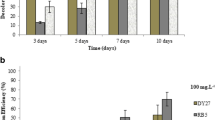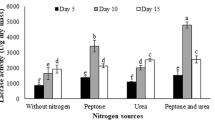Abstract
The decolorization of the recalcitrant dye Remazol Brilliant Blue R (RBBR) by the culture filtrate of Polyporus sp. S133 and the effect of various environmental factors were investigated. Both biodegradation and biosorption were playing an important role in bioremoval mechanisms. The highest biosorption of RBBR in Polyporus sp. S133 was shown by all carbon sources such as sucrose, glucose, fructose, and starch. No biosorption was shown by the addition of aromatic compounds and metal ions; 97.1 % RBBR decolorization was achieved in 120-rpm culture for 96 h, as compared to 49.5 % decolorization in stationary culture. Increasing the shaking rotation of the culture to more than 120 rpm was proven to give a negative effect on decolorization. The highest production of laccase was shown at pH 4 and constantly decreases when the pH level increases. The addition of glucose, ammonium tartrate, Cu2+, and protocatechuic acid was the suitable environmental condition for RBBR decolorization. There was a positive relationship between all environmental conditions and laccase production in the decolorization of RBBR.




Similar content being viewed by others
References
Amanullah, A., Justen, P., Davies, A., Paul, G. C., Nienow, A. W., & Thomas, C. R. (2000). Agitation induced mycelial fragmentation of Aspergillus orizae and Penicillium chrysogenum. Biochemical Engineering Journal, 5, 109–114.
Boer, C. G., Obici, L., Souza, C. G., & Peralta, R. M. (2004). Decolorization of synthetic dyes by solid-state cultures of Lentinula (Lentinus) edodes producing manganese peroxidase as the main ligninolytic enzyme. Bioresources Technology, 94, 107–112.
Camarero, S., Ibarra, D., Martınez, M. J., & Martınez, A. T. (2005). Lignin-derived compounds as efficient laccase mediators for decolorization of different types of recalcitrant dyes. Applied and Environmental Microbiology, 71, 1775–1784.
Field, J. A., De Jong, E., Feijoo, G., & De Bont, J. A. M. (1993). Screening for ligninolytic fungi applicable to the biodegradation of xenobiotics. Trends in Biotechnology, 11, 44–49.
Hadibarata, T., & Tachibana, S. (2010). Characterization of phenanthrene degradation by strain Polyporus sp. S133. Journal of Environmental Sciences, 22, 142–149.
Hadibarata, T., Tachibana, S., & Itoh, K. (2007a). Biodegradation of n-eicosane by fungi screened from nature. Pakistan Journal of Biological Sciences, 10, 1804–1810.
Hadibarata, T., Tachibana, S., & Itoh, K. (2007b). Biodegradation of phenanthrene by fungi screened from nature. Pakistan Journal of Biological Sciences, 10, 2535–2543.
Hadibarata, T., Tachibana, S., & Askari, M. (2011). Identification of metabolites from phenanthrene oxidation by phenoloxidases and dioxygenases of Polyporus sp. S133. Journal of Microbiology and Biotechnology, 21, 299–304.
Hadibarata, T., Yusoff, A. R. M., & Kristanti, A. Y. (2012). Decolorization and metabolism of anthraquionone-type dye by laccase of white-rot fungi Polyporus sp. S133. Water, Air, and Soil Pollution, 223, 933–941.
Hatvani, N., & Mecs, I. (2001). Production of laccase and manganese peroxidase by Lentinus edodes on malt-containing by-product of the brewing process. Process Biochemistry, 37, 491–496.
Kapdan, I. K., Kargi, F., McMullan, G., & Marchant, R. (2000). Effect of environmental conditions on biological decolorization of textile dyestuff by C. versicolor. Enzyme and Microbial Technology, 26, 381–387.
Levin, L., Papinutti, L., & Forchiassin, F. (2004). Evaluation of Argentinean white rot fungi for their ability to produce lignin-modifying enzymes and decolorize industrial dyes. Bioresources Technology, 94, 169–176.
Li, Z. L., Shukla, V., Fordyce, A. P., Pedersen, A. G., Wenger, K. S., & Marten, M. R. (2000). Fungal morphology and fragmentation behavior in fed-batch Aspergillus orizae fermentation at the production scale. Biotechnology and Bioengineering, 70, 300–312.
Mechichi, T., Mhiri, N., & Sayadi, S. (2006). Remazol Brilliant Blue R decolourization by the laccase from Trametes trogii. Chemosphere, 64, 998–1005.
Mittard, A., & Riba, J. P. (1988). Morphology and growth of Aspergillus nigger ATCC 26036 cultivated at several shear rates. Biotechnology and Bioengineering, 32, 835–840.
Nakazawa, T., & Nakawaza, A. (1970). Pyrocatechase (Pseudomonas). Methods in Enzymology, 17, 518–522.
Nielsen, J., Johansen, C. L., Jacobsen, M., Krabben, P., & Villadsen, J. (1995). Pellet formation and fragmentation in submerged cultures of Penicillium chrysogenum and its relation to penicillin production. Biotechnology Progress, 11, 93–98.
Ollikka, P., Alhonmaki, K., Leppanen, V. M., Glumoff, T., Raijola, T., & Suominen, I. (1993). Decolorization of azo, triphenylmethane, heterocyclic and polymeric dyes by lignin peroxidase izoenzymes from Phanerochaete chrysosporium. Applied and Environmental Microbiology, 59, 4010–4016.
Rodriguez Couto, S., Sanroman, M., & Gubitz, G. M. (2005). Influence of redox mediators and metal ions on synthetic acid dye decolourization by crude laccase from Trametes hirsuta. Chemosphere, 58, 417–422.
Soares, G. M. B., Pessoa-Amorim, M. T., & Costa-Ferreira, M. (2001). Use of laccase together with redox mediators to decolourize Remazol Brilliant Blue R. Journal of Biotechnology, 89, 123–129.
Swamy, J., & Ramsay, J. A. (1999). The evaluation of white rot fungi in the decoloration of textile dyes. Enzyme and Microbial Technology, 24, 130–137.
Tien, M., & Kirk, T. K. (1988). Lignin peroxidase of Phanerochaete chrysosporium. Methods in Enzymology, 161, 238–249.
Wesenberg, D., Kyriakides, I., & Agathos, S. N. (2003). White rot fungi and their enzymes for the treatment of industrial dye effluents. Biotechnology Advances, 22, 161–187.
Acknowledgments
A part of this research was financially supported by an Institutional Research Grant from the Universiti Teknologi Malaysia (Vote No. QJ1.30000.2522.02H65).
Author information
Authors and Affiliations
Corresponding author
Rights and permissions
About this article
Cite this article
Hadibarata, T., Yusoff, A.R.M. & Kristanti, R.A. Acceleration of Anthraquinone-Type Dye Removal by White-Rot Fungus Under Optimized Environmental Conditions. Water Air Soil Pollut 223, 4669–4677 (2012). https://doi.org/10.1007/s11270-012-1177-6
Received:
Accepted:
Published:
Issue Date:
DOI: https://doi.org/10.1007/s11270-012-1177-6




